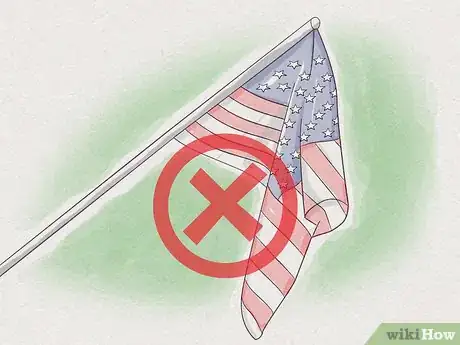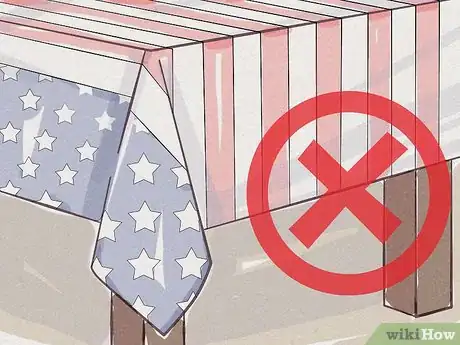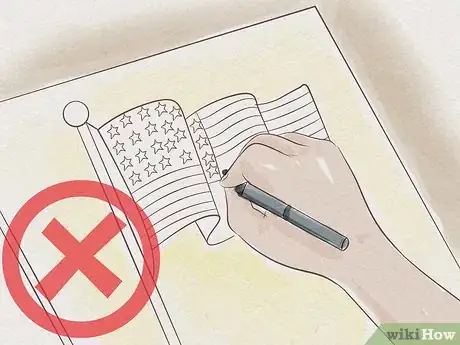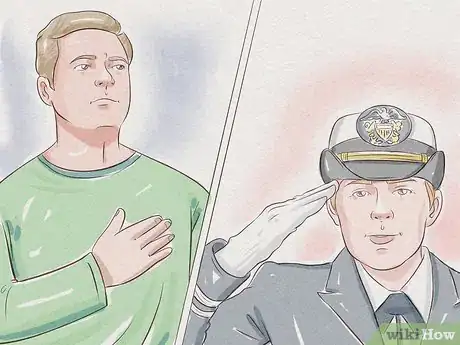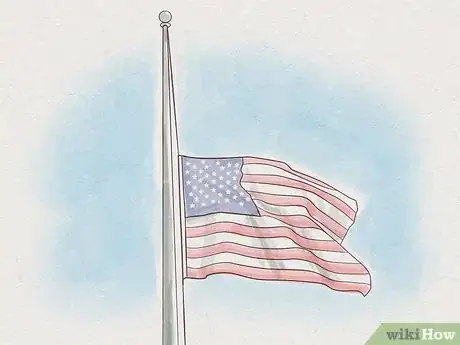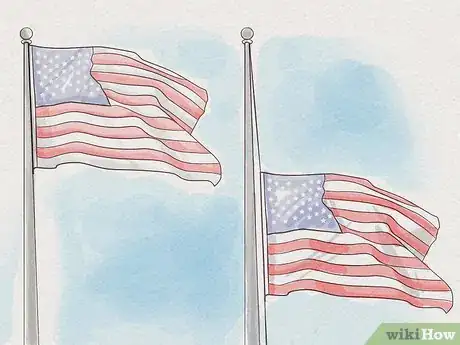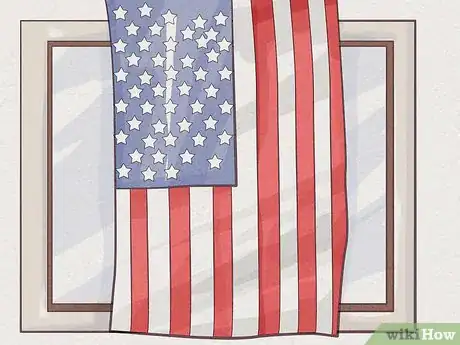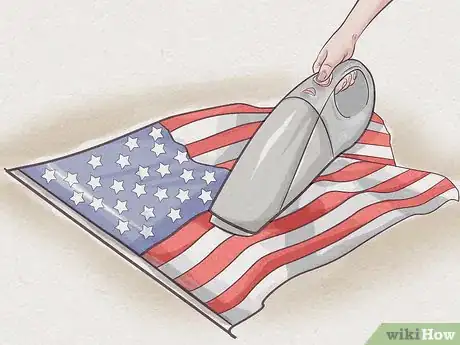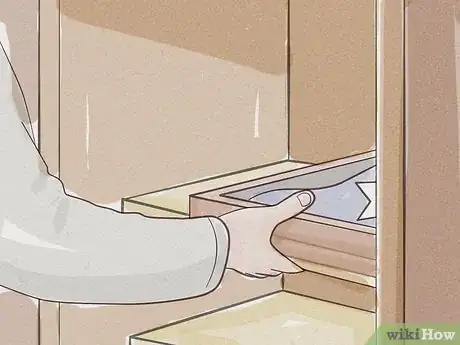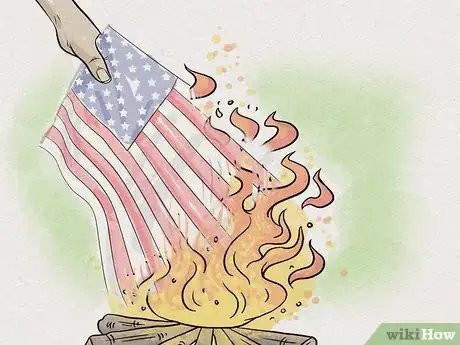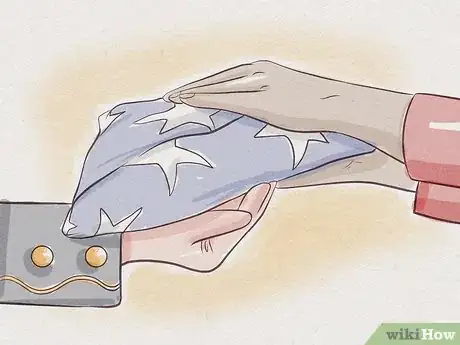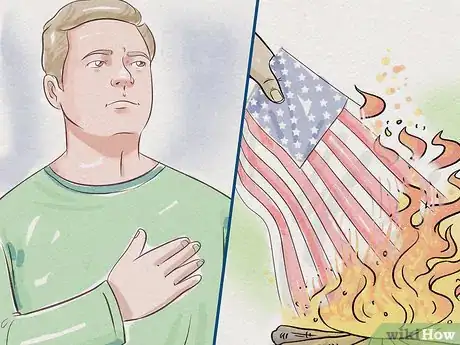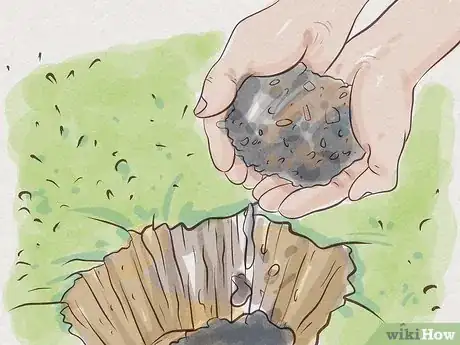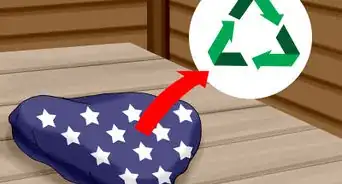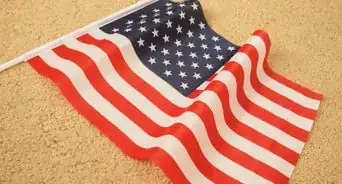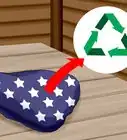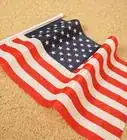This article was co-authored by wikiHow staff writer, Kyle Hall. Kyle Hall works on the content team at wikiHow. He helps manage our team of editors and creates content for a variety of wikiHow projects. Kyle continually looks for new ways to improve the content at wikiHow and make it more helpful and enjoyable for readers. He graduated from Eckerd College in 2015, where he majored in Political Science.
wikiHow marks an article as reader-approved once it receives enough positive feedback. In this case, 84% of readers who voted found the article helpful, earning it our reader-approved status.
This article has been viewed 98,051 times.
Learn more...
The U.S. Flag Code says the American flag “represents a living country and is itself considered a living thing.” If you don’t know the flag code by heart, you might be wondering about the do’s and don'ts of flag etiquette. It can be hard to differentiate between what’s patriotic and what’s offensive. Fortunately, once you learn a few rules and know what things to avoid when it comes to displaying the American flag, you can proudly display Old Glory the right way.
Steps
Practicing Flag Etiquette
-
1Never dip the American flag. Dipping a flag is when you tilt a flag downward in front of a person or thing as a sign of respect. The U.S. Flag Code states that the American flag should never be dipped.[1]
-
2Avoid using the American flag for decorative purposes. American flag buntings are available to be used as patriotic decorations instead. Displaying the flag respectfully on a flagpole is not considered decorative and is acceptable to do.[2]
- For example, you should never use the American flag as a tablecloth or drape it over a podium that someone will be speaking at.
Advertisement -
3Don't use the American flag as part of a costume or uniform. There is a debate over whether this includes wearing clothing like shirts and dresses with the American flag on it. Some people view it as patriotic, others view it as offensive. The only exception to the rule is for military members, police officers, and firefighters, who are all able to wear an American flag patch on their uniforms.[3]
-
4Never draw on or mark the American flag in any way. This includes writing words on the flag, drawing numbers or symbols, or attaching any kind of image to the flag.[4]
-
5Salute the flag properly. People in uniform, members of the armed services, and veterans do the military salute. While it is customary for non-military and non-uniformed persons to remove any headwear and hold their right hand over their heart, the US Supreme Court determined (in their ruling West Virginia State Board of Education v. Barnette) “If there is any fixed star in our constitutional constellation it is that no official, high or petty, can prescribe what shall be orthodox in politics, nationalism, religion, or other matters of opinion or force citizens to confess by word or act their faith therein.” [5]
Raising and Lowering the Flag
-
1Fly the flag at half-staff on special occasions. Flying the flag at half-staff means flying it halfway up the flagpole. You should fly the flag at half-staff on Memorial Day and whenever the president or your state governor declares a period of mourning.[6]
-
2Raise the flag to the peak of the staff first before flying it at half-staff. Do the same when you go to lower the flag from half-staff at the end of the day.[7]
-
3Raise the American flag first and lower it last. If there are any other flags around, they should be raised after the American flag and lowered before it so the American flag is flown the longest.[8]
-
4Never let the flag touch the ground when it’s being lowered. Always be prepared to grab the flag with your hands when it reaches the bottom of the pole.[9]
Displaying the Flag
-
1Shine a light on the flag if you’re displaying it outdoors at night. Take the flag down at sunset if you don’t have an outdoor light to keep it lit up in the dark. You can put it back up at sunrise.[10]
- Install a solar light at the base of your flag pole or somewhere on your lawn. Most solar lights turn on automatically when it gets dark, so you won’t have to worry about forgetting to turn it on at night.
-
2Display the flag higher than non-American flags. Make sure no flag from any state, community, or society is flying above the American flag you’re displaying.[11]
- The only time the American flag should not be flown higher than another flag is when the other flag is a nation’s official banner. Fly the American flag at the same height as the flags of other nations.[12]
-
3Place the union to the observer’s left when displaying the flag on a wall or window. The union is the blue field of white stars.[13]
- For example, if you were to hang the flag on a wall in your home and then stand facing it, the blue field of white stars should be in the top left corner.
Storing the Flag
-
1Clean the flag before storing it to keep it in good condition. Avoid washing the flag in a washing machine, as it might damage the flag if it’s fragile. Use a low-pressure vacuum cleaner to remove any dirt or dust from the flag’s surface.[14]
-
2Fold the flag properly when storing it. Folded properly, the flag should look like a small triangle with only the blue field of white stars visible.[15]
-
3Store the flag in a dark place with low humidity. Light can cause the colors on the flag to fade, and humidity might cause mold to form on the flag.[16]
Disposing of the Flag
-
1Build a fire to dispose of the flag in. This should be done outdoors in an open, safe place with no fire hazards. Make sure the fire is large enough that it will completely burn the flag.[17]
-
2Put the flag in the fire. The flag should be folded properly as if it was going to be stored.[18]
-
3Salute the flag and deliver the Pledge of Allegiance. Have a moment of silence and reflect on the flag and what it symbolizes.[19]
-
4Put out the fire and collect the ashes. Bury the ashes of the flag in a respectful location.
References
- ↑ http://www.usflag.org/flagetiquette.html
- ↑ http://www.usflag.org/flagetiquette.html
- ↑ http://www.usflag.org/flagetiquette.html
- ↑ http://www.usflag.org/flagetiquette.html
- ↑ http://www.military.com/flag-day/flag-ettiquette-dos-and-donts.html
- ↑ https://www.va.gov/opa/publications/celebrate/halfstaff.pdf
- ↑ http://www.military.com/flag-day/flag-ettiquette-dos-and-donts.html
- ↑ http://www.usflag.org/flagetiquette.html
- ↑ http://www.usflag.org/flagetiquette.html
- ↑ http://www.military.com/flag-day/flag-ettiquette-dos-and-donts.html
- ↑ http://www.usflag.org/flagetiquette.html
- ↑ http://www.usflag.org/flagetiquette.html
- ↑ http://www.military.com/flag-day/flag-ettiquette-dos-and-donts.html
- ↑ https://www.sparefoot.com/self-storage/blog/6198-how-to-properly-store-the-american-flag/
- ↑ http://www.usflag.org/fold.flag.html
- ↑ https://www.sparefoot.com/self-storage/blog/6198-how-to-properly-store-the-american-flag/
- ↑ http://www.military.com/flag-day/flag-ettiquette-dos-and-donts.html
- ↑ http://www.military.com/flag-day/flag-ettiquette-dos-and-donts.html
- ↑ http://www.military.com/flag-day/flag-ettiquette-dos-and-donts.html
- ↑ http://www.usflag.org/us.code36.html
